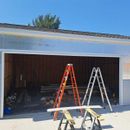Best course of action.
Hello all! First off I live in Northwestern Illinois (climate zone 5A)
I recently built my own garage using the Menards builder software on their site. They had an option for foil based OSB to use as exterior wall sheathing and I chose this thinking it would help reflect heat away in the warm months.
After reading some online articles and chatting with others I discovered I may have a predicament when it comes to finishing the inside. I purchased un-faced fiberglass and intended on placing a plastic vapor barrier over this and then finishing the interior with OSB.
Several folks have said this will create a vapor sandwich of sorts and trap moisture in the wall cavity. I spoke with a representative of Roy O. Martin OSB (product I purchased) and they stated I would be fine with going ahead as planned.
My new course I intend to take is switching to a fiberglass insulation with Kraft backing and then just covering with OSB.
It was suggested I post here as there are many experts who could further guide me along. Thank you all
GBA Detail Library
A collection of one thousand construction details organized by climate and house part










Replies
jamesW80,
Your photo suggests this is a stand alone garage. If used as a garage with limited time as a heated workshop I would tend to go with the kraft faced and OSB approach over plastic film over batts for peace of mind. It would be a more vapor open assembly that will help keep the wall stable over time. There should be low long term moisture load potential in a garage unless heated with an open propane source. Not a good idea for carbon monoxide or water reasons. Wet vehicles shouldn't raise too much of a problem as an intermittent source.
You haven't mentioned if you are insulating the roof/attic. If there are not plans to do so, I would question the value of doing the walls. Your major heat gain and loss will be via the roof and of course the doors opening and closing. Maybe lining the walls with pegboard or slatboard would be a better idea over risking any moisture issues.
The risk of moisture build up mentioned by your friends applies more to homes where the interior moisture from people, cooking, bathing, laundry, etc., combined with vapor and air transport into cold walls during winter can create moisture build up and if high enough, rot and mold. The temperature gradient in homes is higher along with higher humidity 24/7.
I parted company with my Illinois garage many years ago now and I do recall that despite not being used as a part time shop it tended to the dampish side year round. Poor water management around the foundation and extensive tree shading didn't help. Your photo suggests a better starting point for you.
I did neglect to mention the ceiling space. I intended on covering the joists with plastic vapor barrier and OSB using blown cellulose on top of that. Open to any rethinking on that as well.. This is a stand-alone structure with 0 trees nearby and the foundation is 12-16" above grade besides the driveway of course. I intended on putting a natural gas ceiling mount unit for winter heat and a mini-split for summer cooling...